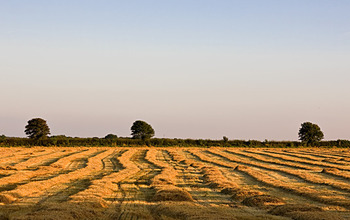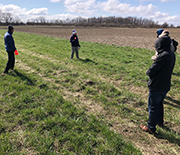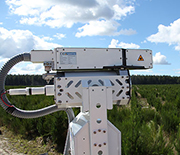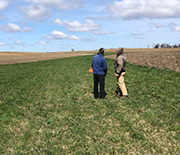News Release 18-072
Scientists launch project to help predict air quality, enhance crop yields
Study looks at how air flows at night

Understanding how air flows at night and over variable topography will help farmers and forecasters.
September 10, 2018
This material is available primarily for archival purposes. Telephone numbers or other contact information may be out of date; please see current contact information at media contacts.
Find related stories on NSF's geosciences risk and resilience interest area.
Tracking how air moves at night near the Earth's surface could provide insights into how air pollution spreads and when it's best to apply pesticides.
This week, a team of University of South Carolina (USC) and University of Illinois (U of I) researchers will launch a project to do just that. Funded by the National Science Foundation (NSF), the two-month experiment -- called Stable Atmospheric Variability and Transport, or SAVANT -- will run from Sept. 15 to Nov. 15 in and near Mahomet, Illinois, and will measure air flow in what's known as a stable boundary layer.
Stable boundary layers form at night over land when the Earth is cooler. Despite their frequent occurrence, they're relatively difficult to understand and observe.
"Airflow near mountains, hills and valleys often has complicated patterns, even though the atmosphere appears quiet," says Chungu Lu, a program director in NSF's Division of Atmospheric and Geospace Sciences, which funds SAVANT. "Understanding these flow patterns is important for predicting air quality, enhancing crop yields and mitigating the impacts of hazardous materials releases, for example."
Because stable boundary layers are challenging to observe, they've previously been under-represented in atmospheric models.
"In recent years, we've learned about stable boundary layers in flat terrain," says April Hiscox, a meteorologist and geographer at USC, and a SAVANT principal investigator. Junming Wang at U of I and David Kristovich of the Illinois Water Survey are also co-leads on the SAVANT team.
"There's also been a lot of work done in mountainous regions," says Hiscox,"but if you look at the United States and much of the world, there's a lot of space that is neither mountainous nor flat."
The researchers will use smoke to track air movement and dispersion along slight dips in the landscape and to determine what conditions affect that movement.
What makes SAVANT unique, the scientists say, is the inclusion of three LIDAR (light detection and ranging) systems, two that scan aerosol concentrations and one that measures 3D wind fields. Each night, the team will release smoke at the top of a single gully and track its movement and changing shape with the LIDAR systems. LIDAR works similarly to radar but uses light from a laser.
The scientists selected four gullies just outside Champaign, Illinois, that represent the shallow topography they would like to understand.
Air flow, wind speed and turbulence will be measured throughout the gullies with the National Center for Atmospheric Research's (NCAR) Integrated Surface Flux System and Integrated Surface Sounding facilities. NSF funds NCAR, a research and development center that supports studies in the field of atmospheric sciences.
The researchers are looking to see what conditions -- level of cloud cover, wind speed and temperature -- are present when stable air layers occur.
The answers will help meteorologists create improved models and make predictions about stable boundary layers, the scientists say.
"The project can assist environmental management and agricultural operations, for example, by knowing when and where to set up anti-frost fans and pesticide applications, as well as in weather forecasting," Wang says.
Stable boundary layers can cause aerosol sprays to drift. Equipping atmospheric scientists with the ability to predict such conditions could have a significant impact on the agricultural community, according to Hiscox.
"The exciting thing about SAVANT is that it integrates many aspects of research and education," she says. "We have an applied aspect with the agricultural setting, a basic science component in that we will learn more about how the atmosphere functions, and educational opportunities for atmospheric researchers."
-NSF-
-
Vincent van Gogh captured landscapes and air flow in “Landscape with Wheat Sheaves and Rising Moon.”
Credit and Larger Version -
Scientists conduct a smoke test before the start of SAVANT.
Credit and Larger Version -
Members of the SAVANT team checking topography for the project.
Credit and Larger Version -
Many of SAVANT's results depend on the use of LIDAR, pictured here.
Credit and Larger Version -
Researchers discuss logistics for a SAVANT project site.
Credit and Larger Version
Media Contacts
Cheryl Dybas, NSF, (703) 292-7734, email: cdybas@nsf.gov
The U.S. National Science Foundation propels the nation forward by advancing fundamental research in all fields of science and engineering. NSF supports research and people by providing facilities, instruments and funding to support their ingenuity and sustain the U.S. as a global leader in research and innovation. With a fiscal year 2023 budget of $9.5 billion, NSF funds reach all 50 states through grants to nearly 2,000 colleges, universities and institutions. Each year, NSF receives more than 40,000 competitive proposals and makes about 11,000 new awards. Those awards include support for cooperative research with industry, Arctic and Antarctic research and operations, and U.S. participation in international scientific efforts.
Connect with us online
NSF website: nsf.gov
NSF News: nsf.gov/news
For News Media: nsf.gov/news/newsroom
Statistics: nsf.gov/statistics/
Awards database: nsf.gov/awardsearch/
Follow us on social
Twitter: twitter.com/NSF
Facebook: facebook.com/US.NSF
Instagram: instagram.com/nsfgov





